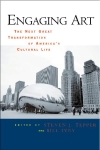« Inconvenient Entaglements | Main | Of zombies, freaks... and the other 90% »
June 15, 2007
Brave New Inconveniences; same old people
by Robert LevineSteven Tepper wrote:
...the greatest barrier for many students when it comes to attending the arts is the notion of "opportunity costs" - many students don't want to commit to an event because they want to wait and see if something better comes along. People want convenience; they want to leave their options open; they want to "drop in and drop by," they want to be able to customize their play lists rather than trust someone else to curate their experiences.
Isn't the last statement called into question by the great success that at least some museum exhibits seem to be having these days? They are as much "curated by someone else" as were exhibits 100 years ago.
The issue of potential concertgoers wanting to keep their options open is not restricted to students. Nor is it new; it seems to be behind the near-universal trend away from the subscription ticket model (which has been going on for a couple of decades now).
There is a trend amongst "big thinkers" to believe that people want different things in the 21st century than they did in the 20th ("people want to 'drop in and drop by'" and such). I'm very suspicious of that notion. People don't change. But what's available to them does. If, for example, 500 channels of cable had been available at the dawn of the TV age, people would have subscribed in droves. The three-network model only existed because of lack of alternatives.
There have always been people creating music, and other forms of art, in their garages (or stables). We used to call it "folk music," among other things. But now it's both easier to create (or to cobble together from pre-existing art) and to distribute new art (although now we call it "content").
Steven Tepper also wrote:
There is probably a place for certain organizations to focus only on artistic innovation, with little regard for audiences. These organizations might be doing critical R&D which has little day-to-day relevance. Good for them. In the end, some will be serving a public interest if their innovations take hold and animate a new generation of audiences and artists.
The problem is that it's hard for orchestras to take those risks. And the non-orchestral organizations that can afford to do so provide models that aren't really "on point" for orchestras. So we get stuck in old models (of concert presentation, for example) that seem to be working less well, but we don't have the resources to take the risks to innovate our way out of the old models.
Posted by rlevine at June 15, 2007 7:01 AM
COMMENTS
Post a comment
Tell A Friend
Resources
Engaging Art: The Next Great Transformation of America's Cultural Life Chapter downloads MP3s Vanessa Bertozzi on audiences and participation Vanessa Bertozzi on involving artists in work Steven Tepper argues the historical context of arts in America
Abstracts
Chapter 4
In & Out of the Dark - (a theory about audience behavior from Sophocles to spoken word)
Chapter 7
Artistic Expression in the age of Participatory Culture (How and Why Young People Create)
Chapter 8
Music, Mavens & Technology
(all chapters in pdf form)
Steven Tepper talks about technology and the future of cultural choice
Lynne Conner on the historical relationship between artist and audience
Lynne Conner on event and meaning and sports
AJ Blogs
AJBlogCentral | rss
culture
Terry Teachout on the arts in New York City
Andrew Taylor on the business of arts & culture
rock culture approximately
Rebuilding Gulf Culture after Katrina
Douglas McLennan's blog
Art from the American Outback
Scott McLemee on books, ideas & trash-culture ephemera
Jan Herman - arts, media & culture with 'tude
dance
Apollinaire Scherr talks about dance
Tobi Tobias on dance et al...
media
Jeff Weinstein's Cultural Mixology
Martha Bayles on Film...
music
Greg Sandow performs a book-in-progress
Howard Mandel's freelance Urban Improvisation
Focus on New Orleans. Jazz and Other Sounds
Exploring Orchestras w/ Henry Fogel
Kyle Gann on music after the fact
Doug Ramsey on Jazz and other matters...
Greg Sandow on the future of Classical Music
Norman Lebrecht on Shifting Sound Worlds
publishing
Jerome Weeks on Books
visual
Public Art, Public Space
John Perreault's art diary
Lee Rosenbaum's Cultural Commentary
Tyler Green's modern & contemporary art blog
Special AJ Blogs
June 14-20, 2007



